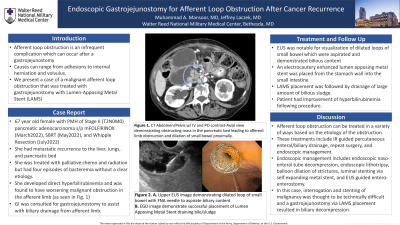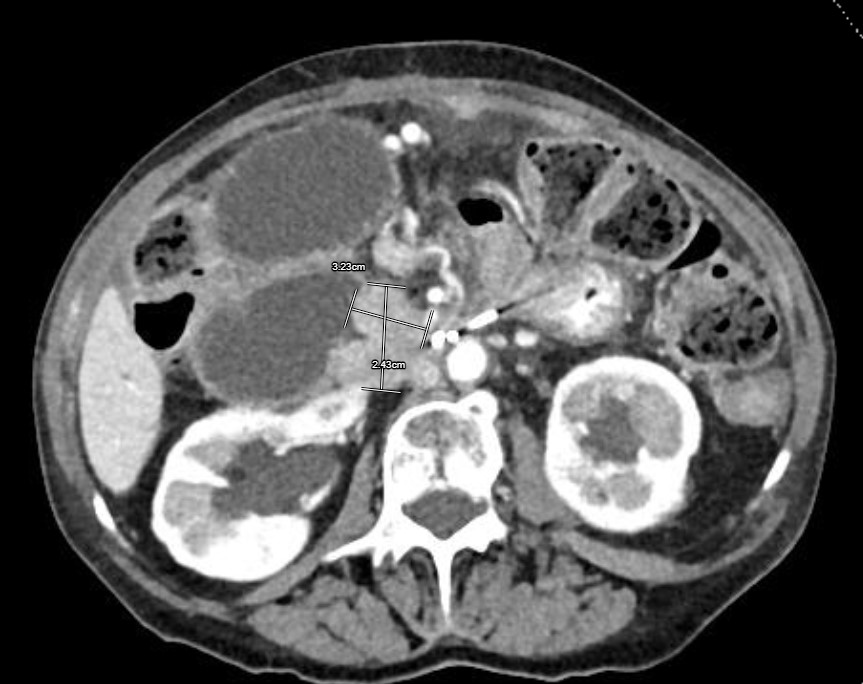Sunday Poster Session
Category: Interventional Endoscopy
P1095 - Endoscopic Gastrojejunostomy for Afferent Loop Obstruction After Cancer Recurrence
Sunday, October 27, 2024
3:30 PM - 7:00 PM ET
Location: Exhibit Hall E

Has Audio
- MM
Muhammad A. Mansoor, MD
National Capital Consortium
Bethesda, MD
Presenting Author(s)
Muhammad A.. Mansoor, MD, Zachary Johnston, MD, Jeffrey T. Laczek, MD
National Capital Consortium, Bethesda, MD
Introduction: Afferent loop obstruction (ALO) is an infrequent complication which can occur after the construction of a gastrojejunostomy; causes include adhesions, internal herniation, and recurrent malignancy. We present a case of ALO due to recurrence of malignancy that was treated with gastrojejunostomy with Lumen-Apposing Metal Stent (LAMS)
Case Description/Methods: A 67-year-old female with past medical history of Stage II T2N0M0 pancreatic adenocarcinoma treated with neoadjuvant chemoradiation then a Whipple operation presented with presented with cancer recurrence in her pancreatic bed and metastatic spread to the liver and lungs. Treatment with palliative chemotherapy was complicated by recurrent bacteremia then jaundice. A CT scan showed obstruction of the afferent limb of the pancreatojejunostomy due to the tumor in the pancreatic bed. Luminal stent placement for decompression of her obstructed jejunal limb was not feasible, so EUS-guided placement of a LAMS from her stomach into the obstructed afferent limb was undertaken.
EUS showed dilated loops of jejunum adjacent the stomach with needle aspiration showing bilious fluid. A 15 mm x 10 mm electrocautery enhanced LAMS was then placed into the dilated jejunum and a large amount of bilious fluid and sludge passed through the LAMS. The patient’s hyperbilirubinemia improved over the next several days.
Unfortunately, patient passed from complications of her metastatic disease a few months later.
Discussion: Afferent loop obstruction is a mechanical complication that occurred in this case due to pancreatic cancer recurrence. It can be managed with percutaneous drainage, surgical revision, endoscopic jejunal stenting, and gastrojejunostomy with LAMS. EUS-guided decompression with a LAMS is quick, technically straightforward, and avoids the need for a percutaneous drain. This case highlights these benefits of using LAMS for malignant afferent loop obstruction for decompression.

Disclosures:
Muhammad A.. Mansoor, MD, Zachary Johnston, MD, Jeffrey T. Laczek, MD. P1095 - Endoscopic Gastrojejunostomy for Afferent Loop Obstruction After Cancer Recurrence, ACG 2024 Annual Scientific Meeting Abstracts. Philadelphia, PA: American College of Gastroenterology.
National Capital Consortium, Bethesda, MD
Introduction: Afferent loop obstruction (ALO) is an infrequent complication which can occur after the construction of a gastrojejunostomy; causes include adhesions, internal herniation, and recurrent malignancy. We present a case of ALO due to recurrence of malignancy that was treated with gastrojejunostomy with Lumen-Apposing Metal Stent (LAMS)
Case Description/Methods: A 67-year-old female with past medical history of Stage II T2N0M0 pancreatic adenocarcinoma treated with neoadjuvant chemoradiation then a Whipple operation presented with presented with cancer recurrence in her pancreatic bed and metastatic spread to the liver and lungs. Treatment with palliative chemotherapy was complicated by recurrent bacteremia then jaundice. A CT scan showed obstruction of the afferent limb of the pancreatojejunostomy due to the tumor in the pancreatic bed. Luminal stent placement for decompression of her obstructed jejunal limb was not feasible, so EUS-guided placement of a LAMS from her stomach into the obstructed afferent limb was undertaken.
EUS showed dilated loops of jejunum adjacent the stomach with needle aspiration showing bilious fluid. A 15 mm x 10 mm electrocautery enhanced LAMS was then placed into the dilated jejunum and a large amount of bilious fluid and sludge passed through the LAMS. The patient’s hyperbilirubinemia improved over the next several days.
Unfortunately, patient passed from complications of her metastatic disease a few months later.
Discussion: Afferent loop obstruction is a mechanical complication that occurred in this case due to pancreatic cancer recurrence. It can be managed with percutaneous drainage, surgical revision, endoscopic jejunal stenting, and gastrojejunostomy with LAMS. EUS-guided decompression with a LAMS is quick, technically straightforward, and avoids the need for a percutaneous drain. This case highlights these benefits of using LAMS for malignant afferent loop obstruction for decompression.

Figure: CT Abd/Pelvis demonstrating obstructive mass along with dilated afferent limb indicating afferent loop obstruction
Disclosures:
Muhammad Mansoor indicated no relevant financial relationships.
Zachary Johnston indicated no relevant financial relationships.
Jeffrey Laczek indicated no relevant financial relationships.
Muhammad A.. Mansoor, MD, Zachary Johnston, MD, Jeffrey T. Laczek, MD. P1095 - Endoscopic Gastrojejunostomy for Afferent Loop Obstruction After Cancer Recurrence, ACG 2024 Annual Scientific Meeting Abstracts. Philadelphia, PA: American College of Gastroenterology.
